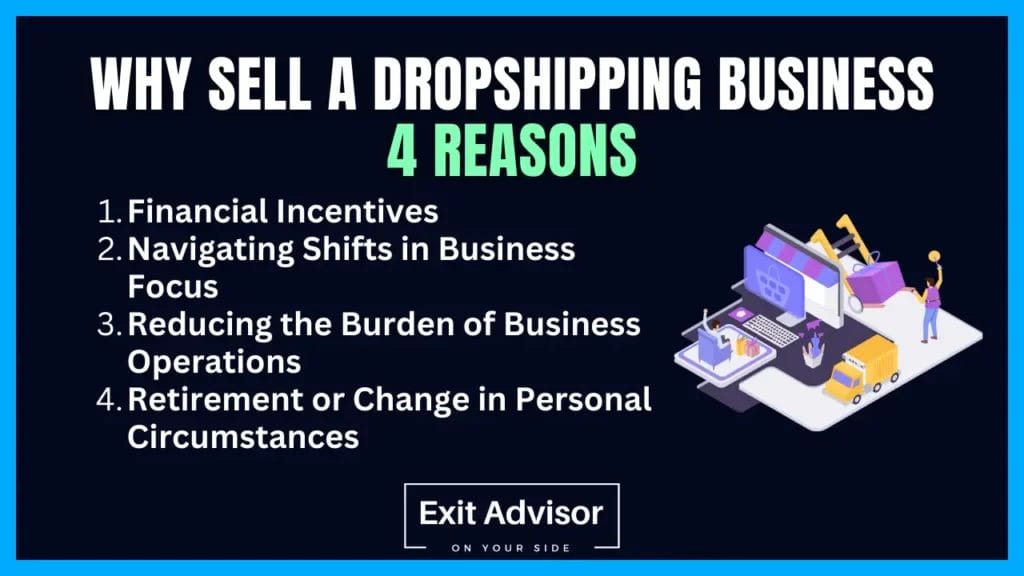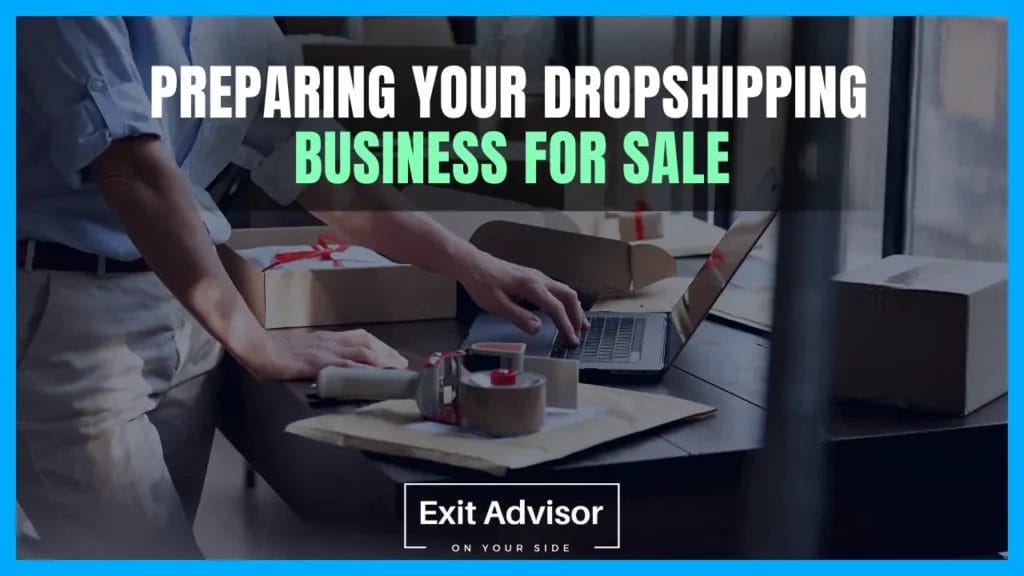Dropshipping is a unique e-commerce model that has changed the dynamics of retail business. It offers an opportunity for entrepreneurs to start an online store without the need to invest in inventory.
However, like any other business, a point may come when you consider selling your dropshipping business. There could be various reasons to sell, such as wanting to venture into different business models, needing quick cash, or simply wanting to take a break.
This guide will walk you through the steps to effectively sell your business, ensuring you get the best price and the transaction occurs smoothly.
| Key Takeaways |
|---|
| Selling a business involves multiple steps, including preparing for sale, identifying potential buyers, negotiating terms, finalizing the sale, and post-sale considerations. |
| Highlighting unique aspects of the business, financial stability, and growth potential can attract individual investors. |
| Showcasing synergies and benefits can appeal to strategic acquirers. |
| Justify your valuation with concrete facts and figures, and be open to negotiation. |
| Providing support during the transition period ensures a smooth handover. |
| Legal requirements, including the transferability of licenses and permits, must be met before finalizing the sale. |
Definition and Basics of Dropshipping
Understanding the Core Concept
Dropshipping is a retail fulfillment method where a store doesn't keep the products it sells in stock. Instead, when a store sells a product using the dropshipping model, it purchases the item from a third party and has it shipped directly to the customer. As a result, the merchant never sees or handles the product.
The Evolving Landscape of Dropshipping in E-commerce
The landscape of dropshipping in the e-commerce industry has significantly evolved over the years.
As technology advances and e-commerce platforms become more sophisticated, dropshipping has become increasingly accessible and profitable. It has empowered numerous entrepreneurs to start retail businesses with minimal upfront costs.
Dropshipping has revolutionized e-commerce by simplifying supply chain management, enabling retailers to focus more on customer experience and less on logistics and inventory.
Why Sell a Dropshipping Business? 4 Reasons

A variety of reasons can prompt an entrepreneur to sell their dropshipping business. Below, we delve into some of the most common ones.
- Financial Incentives: One of the most compelling reasons to sell a dropshipping business is the financial gain. Over time, as the business grows and becomes more profitable, its market value increases. Selling the business can quickly convert this increased value into a substantial cash influx. This lump sum can be used to settle debts, invest in new ventures, or simply for personal enrichment.
- Navigating Shifts in Business Focus: Sometimes, a shift in personal interests or market trends could drive an entrepreneur to sell the business. As markets evolve, staying relevant might require venturing into new niches or embracing different business models. Selling the existing business might be a strategic move to free up resources for these new opportunities.
- Reducing the Burden of Business Operations: While dropshipping simplifies retail operations, managing the business can still be taxing. This is especially true if it has grown substantially or the entrepreneur juggles multiple ventures. Selling the business can help reduce this operational burden, allowing the entrepreneur to focus on other projects or enjoy a less stressful lifestyle.
- Retirement or Change in Personal Circumstances: Personal circumstances such as retirement, health issues, or changes in family situation can also necessitate the sale of the business. In such cases, selling the business ensures it thrives while providing the owner a financial cushion for the next phase of life.
Remember, considering the financial implications and future strategic plans, the decision to sell should be well thought out. It's a significant step that requires careful planning and detailed preparation to ensure the best outcome.
Step 1. Preparing Your Dropshipping Business for Sale

Assessing Business Viability
Before putting your dropshipping business on the market, examining its viability thoroughly is crucial. This allows potential buyers to understand the strengths and weaknesses of the business, and it aids you in setting a fair and attractive selling price.
Financial Health Check
Start by evaluating the financial health of your business. This involves reviewing key financial data such as revenue, net profit, and sales trends. Analyze your monthly and annual sales, peak sales periods, and the cost of goods sold. A strong financial performance will undoubtedly make your business more appealing to potential buyers.
Analyzing Market Trends and Competitive Landscape
Next, analyze the market in which your business operates. Understand the current e-commerce trends, future market prospects, and your position on your competitors. This will provide insights into the business's potential for growth and profitability, which is valuable information for buyers.
Documentation of Business Processes
A well-documented business is easier to sell. It gives potential buyers a clear picture of how the business operates, making the transition easier.
Developing Standard Operating Procedures (SOPs)
Create comprehensive Standard Operating Procedures (SOPs) for all processes, such as order fulfillment, customer service, and supplier relations. This will give the new owner a clear guide on how to run the business efficiently.
Organizing and Streamlining Financial Records
Ensure that all financial records are organized and easily accessible. This includes profit and loss statements, balance sheets, tax returns, and bank statements. Streamlined financial records make due diligence easier for buyers and demonstrate your commitment to transparency.
Elevating Brand Image
The brand image can significantly influence a buyer's perception of your business. Thus, it's important to focus on enhancing it.
Enhancing Branding and Packaging
Invest time and resources to improve your branding and packaging. This could involve a website redesign, a new logo, or improved product packaging. A strong brand image can set your business apart and attract more buyers.
Spotlighting Customer Reviews and Testimonials
Positive customer reviews and testimonials can significantly enhance a business's reputation. If you have these, highlight them in your sales materials. If not, consider encouraging satisfied customers to leave reviews and testimonials that can be shared with potential buyers.
Remember, preparing your dropshipping business for sale can be a time-consuming process. However, the time and effort put into it can significantly increase your chances of selling your business at the best possible price.
Step 2. Setting the Right Price for Your Dropshipping Business
Determining the right price for your dropshipping business is a balance between attaining a fair return on your investment and setting an attractive price for potential buyers.
Valuation Methods
Setting the right price involves understanding the different valuation methods that can be applied to your business.
Deep Dive into Revenue Multiples
Revenue multiples is a common method used in business valuation. This method involves taking the gross revenue of your business over a specific period (usually one year) and multiplying it by a figure that is typical for your industry. This method provides a valuation based on the business's ability to generate revenue.
Understanding Earnings Multiples
Earnings multiples, on the other hand, consider net income rather than gross revenue. This method might be more complex as it requires a thorough understanding of your business's expenses, but it often accurately represents a business's worth.
Thorough Evaluation of Inventory
In a dropshipping business, inventory can primarily be the agreements with suppliers or the existing customer base. Evaluating the value of this “inventory” can help increase your business's attractiveness to buyers.
Assessing Debts and Liabilities
Existing debts and liabilities should also be factored into the valuation. These could decrease the value of your business, so they must be accurately recorded and disclosed.
Projecting Future Revenue Streams
Projecting future revenue streams involves analyzing market trends and your business's historical performance to forecast future income. A business with strong projected revenue can command a higher sale price.
Identifying Emerging Market Opportunities
Identifying emerging market opportunities can also add value to your business. If your business is well-positioned to leverage potential growth areas in the market, this can be highly attractive to potential buyers.
Remember, setting the right price for your business is crucial. A price that is too high may deter potential buyers, while a price that is too low might result in a loss on your investment. It is recommended to seek advice from business valuation experts to ensure the price is fair and justifiable.
Step 3. Marketing Your Dropshipping Business for Sale

Marketing your dropshipping business effectively is crucial to attract potential buyers. It involves preparing a comprehensive sales pitch, leveraging online platforms for visibility, and harnessing the power of social media and networking.
Crafting a Comprehensive Sales Pitch
Building a Compelling Business Narrative
Your business narrative should tell the unique story of your dropshipping business – its inception, journey, key milestones, and future potential. This story should be compelling enough to pique the interest of potential buyers, making them want to learn more about your business.
Spotlighting Key Differentiators
Highlight what sets your business apart from others. This could be your unique selling proposition (USP), niche market, strong supplier relationships, or impressive customer satisfaction ratings. These differentiators can provide compelling reasons for a buyer to choose your business over others.
Leveraging Online Platforms
Exploring E-commerce Marketplaces
E-commerce marketplaces, like Flippa or Shopify's Exchange, are excellent platforms to list your business for sale. They provide a wide audience of potential buyers interested in e-commerce and dropshipping businesses.
Utilizing Business Brokerage Websites
Brokerage sites, like BizBuySell or BusinessesForSale, can also effectively reach potential buyers. These websites specialize in listing businesses for sale across various industries, including dropshipping.
Harnessing Social Media and Networking
Engaging Potential Buyers
Social media platforms are a powerful tool to engage with potential buyers. Use platforms like LinkedIn, Facebook, and Instagram to get the word out about your business sale. Post regular updates about your business, engage with potential buyers, and respond promptly to inquiries.
Establishing Trust and Credibility
Establish credibility by being transparent about your business operations, financial health, and future potential. Share testimonials, reviews, and endorsements to create trust with potential buyers.
Remember, marketing your business requires patience and persistence. Follow a consistent approach, engage with potential buyers, and stay open to feedback and negotiations.
Step 4. Navigating the Sale Process

Successfully selling your business involves several important steps. Maintaining transparency and professionalism throughout this process ensures a smooth transition.
Identifying Potential Buyers
Targeting Individual Investors
Individual investors often seek lucrative opportunities in the e-commerce and dropshipping space. Highlighting the unique aspects of your business, its financial stability, and potential for future growth can be compelling points for these investors.
Appealing to Strategic Acquirers
Strategic acquirers are typically other businesses in your industry or a related industry looking to expand their operations, market share, or customer base. Your business could be an attractive addition to their portfolio. Make sure to showcase the synergies and benefits that a potential acquisition could bring.
Negotiating Terms and Conditions
Effective Price Negotiation Strategies
Remember that while you want to maximize the sale price, potential buyers are also looking for a fair deal. Be ready to justify your valuation with concrete facts and figures, and be open to negotiation within a reasonable range.
Structuring a Smooth Transition Period and Support
You may need to provide support during the transition period to ensure a smooth handover. This could involve training the new owner, introducing them to key contacts, or helping with operational tasks. Outline these terms clearly during the negotiation process.
Finalizing the Sale
Addressing Legal Considerations
Before finalizing the sale, engage a legal expert to review the sales agreement and ensure all legal requirements are met. This includes ensuring all your business's licenses and permits are current and transferable.
Successfully Closing the Deal
It's time to close the deal once all terms are agreed upon and the legal checks are complete. This typically involves signing the sales agreement, transferring ownership documents, and receiving payment. Celebrate your success – you've successfully sold your dropshipping business!
Step 5. Post-Sale Considerations
After successfully closing the deal, it's important not to overlook the post-sale considerations. These are key steps to ensure a seamless transition for the new business owner and adequately positioning yourself for future pursuits.
Ensuring a Seamless Ownership Transition
Facilitating Handover of Business Assets
Facilitating the handover of business assets is crucial in the post-sale phase. Ensure the new owner can access all necessary digital assets, physical inventory, supplier and customer databases, and other critical business resources. A well-structured and organized handover will help prevent disruptions in business operations and maintain customer trust during the transition.
Proactive Communication with Customers and Suppliers
Once the sale is complete, timely and transparent communication with customers and suppliers is crucial. Customers should be assured that the business will continue to provide the same service or product quality. On the other hand, suppliers should be informed about the new ownership to sustain a good working relationship.
Planning for the Future
Exploring New Opportunities
With the sale of your business complete, it's time to look towards new opportunities. Whether starting a new venture, investing in other businesses, or taking a well-deserved break, carry forward the learnings from your previous experience.
Focusing on Personal and Professional Development
Use this transition period to focus on personal and professional development. Assess the skills you've garnered from your business sale and identify areas for growth. This could be furthering your education, attending industry seminars, or simply taking time for personal reflection and goal setting. This preparation will set the foundation for your next steps and future success.
Conclusion
Selling your business is a monumental milestone, marking the culmination of your hard work, perseverance, and entrepreneurial spirit. This journey may seem daunting, from establishing credibility to navigating the sale process and considering post-sale responsibilities. However, by adhering to these methodically outlined steps, you can ensure a smooth and successful transition.
Whether you're targeting individual investors or appealing to strategic acquirers, the key lies in transparency, professionalism, and carefully planned negotiations. Don't overlook the importance of a well-structured handover and proactive communication post-sale, as these steps secure the continuity of your business under new ownership.
Finally, the conclusion of one chapter invariably opens the door to exciting new opportunities for personal and professional growth.
Carry forward the invaluable insights and experiences from this journey, and you'll be well-equipped for your future endeavors. Selling a business is not just an end—it's a new beginning. Embrace it with the knowledge that you’ve done the best for your business and yourself.










